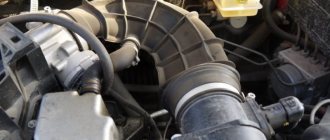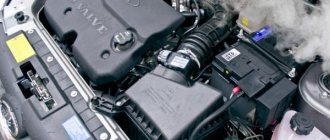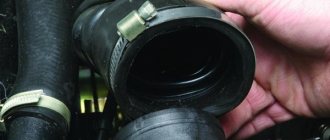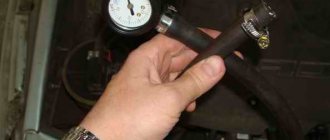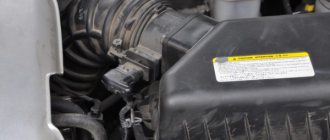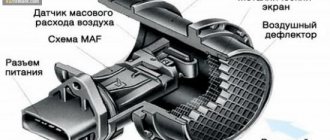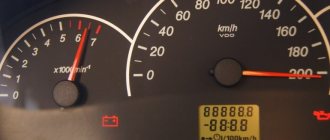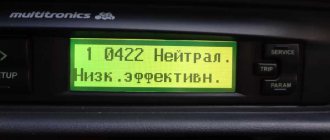Modern injection cars form the air-fuel mixture based on the readings of the volume of air entering the engine. Several types of meters are used to calculate the amount of air. Most often this is a mass air flow sensor (MAF) or MAP (absolute pressure sensor).
If the engine sucks in oxygen bypassing these sensors, many problems arise that affect the performance of the vehicle. Therefore, at the slightest suspicion, this malfunction should be identified and eliminated.
Finding air leaks is not a simple procedure and often requires special equipment
Looking for air leaks
Since injection and carburetor engines are structurally different, especially their fuel and air systems, we will consider possible places for air leaks separately.
Injection cars:
- Vacuum booster and its hoses;
- Idle air control (if equipped) in the sensor area;
- Intake manifold gasket;
- Canister purge valve;
- Throttle assembly gasket;
- Injectors (via O-rings);
- The pipe between the throttle body and the air filter.
- Pipes of the crankcase ventilation system.
- Receiver studs.
Read - what happens if you turn off the adsorber.
Carburetor:
Points 1 and 3 above are also typical for carburetor engines. Next, you should pay more attention to the carburetor, since it is there that air is most often sucked in, namely:
- Through the gasket located under the carburetor;
- Through failed diaphragms of the economizer damper, starting throttle.
- Incomplete fit of the throttle valve (for example, as a result of its clogging);
- Through the fuel mixture quality screw;
- Air leaks through the throttle axles.
- Through the gasket between the float chamber cover and the body. As a result of strong compression, the housing surface bends; it can reach 1-2 mm in the center. A gasket won't help the situation. Needs sanding.
Prevention of use
The throttle valve itself is designed for the entire life of the vehicle, that is, it does not have a replacement frequency. Therefore, it is replaced when the unit fails due to mechanical failure, failure of the entire engine, or other critical reasons. More often than not, the throttle position sensor mentioned above fails. Accordingly, it must be replaced.
For normal engine operation, the throttle valve must be periodically cleaned and reconfigured. This can be done either when the above signs of breakdown appear, or simply periodically so as not to bring it to such a state. Depending on the quality of the fuel used and the operating conditions of the vehicle, it is recommended to clean the throttle valve when changing the engine oil, that is, every 15...20 thousand kilometers.
Symptoms
It is important to understand that a severely lean fuel mixture will cause a corresponding error on the instrument panel (injector) - this will indicate a large air leak, which will prevent stable operation of the engine.
A slight depletion of the mixture will be one of the reasons for floating idle speeds, which the ECU can somehow correct.
Symptoms of air leaks are not difficult to distinguish from any others, these are:
- Difficulty starting the engine;
- Increased fuel consumption;
- Floating idle speed leading to engine stoppage;
- Reduced power, engine does not pull.
It's worth explaining a little here.
As for point 2 - when air is leaking, you have to spend more time driving in a lower gear, while the gas pedal needs to be squeezed almost to the floor, keeping the speed increased.
According to point 3, the idle speed does not hold well, and at 900-1000 rpm the car may stall. Many owners of carburetor cars immediately try to correct the situation with the help of a screw for the quality and quantity of the fuel mixture, but as a rule, this does not help, since excess air does not flow through the idle channel, but, for example, through the gasket under the carburetor.
According to point 4, other reasons besides air leaks can lead to a drop in power; it all depends on what systems are structurally implemented in the engine.
Reduced idle speed is typical for MAF systems where a mass flow sensor (mass fuel flow sensor) is installed in the intake tract - errors in its operation are possible.
In systems with an absolute pressure sensor (with a MAP sensor), a drop in power can be caused by errors in the lambda probe, misfires, and again a lean mixture.
Many car owners make the mistake of immediately changing the IAC or mass flow sensor when the idle is floating. There is no need to do this. First, diagnose the engine for possible air leaks using the methods listed below.
Diagnostics
To check your car for leaks, you can use the ELM327 scanner, you can read how to do this here. This scanner is capable of diagnosing your car and indicating whether it has this malfunction. But, checking with a scanner will not always be a reference, since the leak may be insignificant and the ECU simply may not notice it.
It is best to check the suction using the old proven method, or rather several, which are given below.
First way
It is necessary to unscrew the mass air flow sensor from the air filter housing. It is secured with two 10mm key bolts. We take out the mass air flow sensor and start the engine.
With the internal combustion engine running, we close the sensor hole with our hand or a bag, the car should stall and the intake corrugation should shrink. A vacuum is created in the engine, which, in the absence of air leaks, will persist for a long time and the corrugation will remain compressed.
If the corrugation on your car instantly expands or does not shrink at all, then this indicates the presence of suction.
Second way
To diagnose using this method, you will need a pump or compressor.
Here, just like in the first case, you need to unscrew the mass air flow sensor from the body and insert the bag between it. Then screw it back, thereby blocking air access to the engine.
On the receiver we find a fitting with a plug. We remove the plug and connect the pump there, pump up pressure into the receiver and listen to where the hissing will come from. To more accurately determine the location of the leak, you can use a soap solution with a spray bottle. We spray the areas of possible leakage with this solution and look for the appearance of bubbles.
Video on methods 1 and 2
Third way
This method is widely used at service stations. The search for suction is carried out using a smoke generator. This method is similar to the second, but instead of air, smoke is pumped into the receiver. If the engine has a choke, then smoke will flow out of this place.
Detecting air leaks in the intake manifold
The essence of the problem is that in engines with the above systems, excess air penetrates into the combustion chamber.
It is sucked in after the MAF/DBP (absolute pressure sensor). As a result of this, the ECU receives data that diverges from the real ones and this causes the engine to operate incorrectly.
One of the problem areas is the gasket between the intake manifold and the cylinder head. Here, air leaks can be minimal, it is difficult to visually identify minor damage and therefore not everyone pays attention to this place.
But seals in the form of gaskets and sealant can leak in other places, the reason for this may be:
- Decrease in their elasticity due to overheating or long service life;
- Frequent use of cleaning agents for throttle assemblies and carburetors. These products gradually soften the seals, which promotes air leaks.
- Mechanical impact on gaskets if they are replaced incorrectly.
Where exactly can air be sucked from?
There are quite a lot of places for the passage of unaccounted air. You need to understand that the culprit may be either a leaky rubber band or a crack in the intake manifold.
Most often, air is sucked from:
If you suspect that there is unaccounted air in the intake manifold, you should immediately check all of the above areas. As a rule, the suction is quite easy to find. If difficulties arise, it is recommended to seek help from a service station or acquire a special device for searching for intake leaks.
Air leak in the manifold
Standard places for air leaks in the manifold are:
- Microcracks in air ducts;
- Loose connections;
- Through the hoses of the vacuum brake booster;
- Through the fuel injector seals.
It is through these places that excess air, which is not taken into account by the mass air flow sensor, enters the combustion chamber.
Answers (6)
The carburetor may be clogged. When I had a nine, I also had a problem - you start it, and then it starts to twitch, then it completely stalls. I went to the service center, cleaned the carburetor, replaced the filter and something else, and everything became normal.
The problem is in the carburetor, it needs to be cleaned and adjusted properly. Go to the service center, they should charge you some money for it.
the carburetor and filters are clogged - this needs to be addressed, it should go away
There can be many reasons. Carburetor, jets, fuel filters, pump
here you need a calculation method, it seems to me that the problem is in the fuel pump
There is a telescope in the air damper drive; when starting, it must open the air damper slightly to change the composition of the mixture, otherwise the spark plugs will be flooded with gasoline and the engine will stall. You can check its operation in the following way: pull out the air damper drive all the way (the damper will close) and press the damper from above with your finger. The damper should turn and return to its original position. If the shutter does not move or jams, then the telescope must either be removed from the “VD 40” or replaced. At the same time, bleed out the idle speed jet and check whether power is supplied to the idle speed solenoid valve.
The VAZ 2107 is not the best model among cars in its class when compared with foreign equivalents. However, thanks to its low price and accessible service, the car has been popular throughout the post-Soviet territory for many years. The car was produced from 1982 until 2014. That is, the oldest model is more than 30 years old. During such a period of operation, the owner will be able to encounter all types of faults and investigate most of the causes of problems.
After several years of operation, the VAZ 2107, as well as the almost identical model 2105, begins to show a new character with changes not for the better. Malfunctions associated with the power unit and its body kit are of a different nature, but are symptomatic:
- the engine stalls periodically;
- does not maintain stable speed;
- unstable operation at idle;
- hard to start;
- insufficient power;
- increased fuel consumption.
All malfunctions appear for two reasons: violation of adjustments or wear of parts.
Looking for air leaks
There are many methods for finding air leaks; we’ll tell you about the most effective ones:
- Forced shutdown of air supply to the engine.
- Use of a smoke generator;
- Compressed air;
- Clamping of hoses;
- Wetting possible leak points with gasoline, carburetor cleaner, VD 40 or other flammable liquids.
Air shut off
The essence of the first method is to disconnect the pipe from the air filter and block it. With this we will check whether air is passing through the seals in front of or behind the flow meter.
Algorithm of actions:
- Unscrew the air duct in the area of the air filter;
- We start the car;
- We close the hole in any possible way.
If after the flow meter (mass air flow sensor) the pipe is strongly compressed (residual air is sucked in) and the engine stalls, this is normal. And if the engine continues to work, albeit intermittently, then by the hissing that will most likely occur, you can determine where the air is being sucked in.
The disadvantage of this method is that when the engine is running and the corrugation is blocked, oil can be drawn into the throttle assembly through the oil baffles. This is especially dangerous on engines with high mileage or after major repairs.
Checking suction with a smoke generator
Many will notice that checking air leaks with a smoke generator is done at a service station and not everyone has such a device in the garage. But who is stopping you from making a smoke generator yourself with your own hands, because in reality, there is nothing complicated here.
Prepare:
- 12V car compressor or regular pump.
- A food container with a volume of at least a liter. Please note that the container must have a tight lid, preferably silicone.
- Two tubeless nipples. In one there should be a spool through which pressure from the compressor will be supplied, in the second - unscrew the spool, since through it smoky air will be supplied to the system.
- 2-3 cigarettes.
Make holes on both sides of the container at the same level and insert tubeless nipples into them. Sealant can be used to seal.
Connect the hose to the nipple without spool. The hose can be taken from the return valve of the absorber purge valve.
Further procedure:
- Disconnect the pipe with the flow meter from the air filter and close it in any way possible.
- Disconnect the crankcase ventilation hose and plug it. Instead, connect the hose coming from the container.
- We insert the smoked cigarette into the nipple without a spool with a filter and close the lid tightly.
- Connect the compressor to the first nipple and turn it on.
The forced air will create pressure, and the smoke from the cigarette will begin to spread throughout the system and, where there is suction, it will begin to come out.
Another variation of the smoke generator.
Clamping the hoses
In this case, you need to be careful, since air leaks are detected with the car running.
The essence of the method is that at the first stage, places of air hissing are detected by ear, and at the second stage, when pinching and releasing the hoses of the vacuum booster, fuel pressure regulator and others going to the intake manifold, engine operation is monitored.
If any changes are observed in its operation during the above-described manipulations, then a specific area will be checked in depth.
Spray method
This method must be used with caution so as not to burn the car because you will have to use flammable liquids (gasoline, carburetor cleaners, etc.). Do not overheat the engine or use open fire.
The essence of the method is as follows: through the supposed places of air leakage, flammable vapors, for example, from gasoline, should enter the system. As a result, the mixture will become richer and the engine operating mode will change.
To accomplish your plan, fill the syringe with a flammable mixture and start the car. Using a syringe, carefully spray the liquid in places where the likelihood of air leaks is maximum, and this is:
- All pipes and their connections from the air filter to the valve cover;
- Gaskets for injectors and between the cylinder head and the intake manifold;
- At the junction of the throttle pipe and the receiver.
An increase in engine speed will indicate that a flammable liquid is entering the system through this place, which means it is sucking in air here.
Second spraying method
In this case, not a flammable mixture is used, but a soap solution with a spray. You can use any detergent diluted with water.
To implement the method you will need:
- 12V car compressor (foot or hand pump) with an adapter for inflating mattresses (usually included).
- Spray bottle with detergent.
- Cellophane bag.
- A rubber pipe of suitable diameter, 1.5 meters long.
Procedure:
- We remove the pipe from the flow meter (mass air flow sensor), cover the hole with a bag and put everything back, tightening the clamps well.
- We assemble the circuit - compressor, adapter, pipe.
- Instead of the air recirculation valve, we connect our pipe. Some cars may have a plug. You can also use the brake booster connection for connection.
Turn on the compressor. It will be noticeable how the air supply corrugation has swollen.
Then listen carefully to where the hissing is coming from. We wet all possible suction points with a soap solution. Pay attention to the connection fittings for vacuum brake booster pipes, ventilation ducts, and injector rubber seals.
In places where air is leaking, bubbles of the soap solution will be observed.
Methods for checking tightness
There are several ways to check for leaks. Some are faster than others, and some require expensive equipment. Consider the following methods to find the best solution for your case.
Inspect and check for loose hoses on the engine
The first place to check for vacuum leaks is the hoses on the engine. Check for cracks or loose fasteners. Each car has a unique vacuum tube pattern. Make sure the clamps are tight enough.
Try moving the clamps from the side. If they move easily, they need to be tightened. If you still cannot determine the location of the leak, inspect the surfaces further.
Spray soapy water around the intake area
This is probably the easiest and cheapest way to check for air leaks. Spray soapy water around the intake manifold and damaged hoses while the engine is running. You will see air bubbles in the leak areas.
Watch a video on how to look for air leaks using a soap solution:
Use a smoke generator
This is the professional way. Auto mechanics use it to check air leaks within a few minutes. But this will require expensive equipment.
Spray carburetor cleaner
There are those who use carburetor cleaner to detect air leaks. To do this, start the engine at idle speed. Spray cleaner onto areas you suspect of leaks. The engine speed will begin to increase when there is air leakage.
This is because carburetor cleaner will get into the engine and burn with the fuel.
This is a dangerous method for checking air leaks. Sprays are highly flammable. Have a fire extinguisher ready!
Features of testing on carburetor engines
As we said above, the first thing you need to pay attention to on such engines if you suspect an air leak is the carburetor.
Check that all fuel flows through idle. To do this, start the car and disconnect the power wire from the solenoid valve.
If the engine stalls, the situation is simplified, since the valve is working. Remove it and unscrew the idle jet. Check the diameter of the jet hole; it should be 0.40 - 0.45 mm (see the characteristics of your carburetor). If the diameter of the jet is larger than according to the specifications, replace it.
Start the engine and try to set it to XX by unscrewing the EMC. If this cannot be done and it is felt that the engine does not have enough fuel, then it means that air is being sucked somewhere.
Pay attention to possible bending of the carburetor flange. To check whether air is sucking under it or not, pour water under it.
If the engine starts to stall, then the problem is in the bend. In this case, we do not use flammable liquid, it is so dangerous. See the video from Nail Poroshin for all the details.
Adjustment on VAZ 2101-VAZ 2107?
Check whether the damper needs adjustment by removing the air filter housing from the carburetor (read more in the article: “Replacing the air filter housing on domestic cars”).
Take a look at the carburetor and the choke - it should open completely, and the choke should be completely recessed. Everything is smooth, without bevels. Now move into the car interior and pull out the choke completely as far as you can. Go out and look in the engine compartment again, find the damper - it should close completely. Incomplete closure is allowed, but it is even difficult to determine by eye. When the damper is positioned exactly horizontally, it may touch the walls of the carburetor chamber - it will be very difficult for it to open again, so a barely open damper is allowed.
Note! Having determined that the damper opens and closes well, you can put the removed parts back in place and drive on. In case of deviations, the drive needs adjustment. Otherwise, when fully opened, the engine will begin to idle unstably when warm and consume excess gasoline, and when fully closed, the car will have difficulty starting when cold. These are the main symptoms of an unadjusted air damper.
Let's move on directly to the adjustment: it is done by means of a screw securing the rod that controls our damper. First loosen and make sure the choke is fully open. To ensure that the damper is fully opened, remove the choke so that there is a stroke of approximately 1 mm left until it is fully extended. Adjustment can be made with the choke fully extended, lightly pressing the cable, tightening the screw (shown in the second photo).
Note! Upon completion, make sure that the damper opens and closes fully, without any jamming, by using the choke handle.
Diesel engines
In a diesel engine, diesel fuel enters the cylinders bypassing two fuel subsystems - low and high pressure. As a rule, it is in the low pressure area that air leaks occur.
This can happen through many pipeline joints, connections of fuel system elements, including the fuel injection pump.
The problem is aggravated by another point. To reduce the cost of producing diesel cars on modern models, instead of traditional brass tubes, plastic products are used, which wear out much faster.
Aggressive environment, vibrations, temperature changes - all this negatively affects their performance. This also applies to seals. As a rule, all this begins to manifest itself after 120-150 thousand km. mileage
Often, obvious leakage of diesel fuel when the engine is not running can indicate a problem area.
But when the car is running, when fuel is pumped from the tank, a pressure is created in the system that is lower than atmospheric pressure and therefore it is problematic to immediately identify air leaks.
Signs
The bottom line is that the mixture of diesel fuel and air entering the fuel injection pump when starting the engine does not allow it to perform its functions 100%, i.e. overloads it with a large amount of air in the fuel chamber.
When the car is already running, fuel enriched with air foams heavily and increases in volume. Therefore, at high speeds, the fuel injection pump does not have time to pass it through itself.
As a result, when you try to start a diesel car in the morning, you have to oil the starter for a long time, and you will see a little smoke from the exhaust pipe. And when driving or standing at traffic lights, the engine may stall due to insufficient diesel fuel entering the cylinders.
Causes
Causes of air leaks in diesel cars:
- Wear of rubber seals including fuel filters;
- Loosening clamps;
- Damage to the fuel tank;
- Wear and cracking of hoses;
- Damage in the return line;
- Wear of seals in the fuel injection pump cover, drive shaft, fuel supply lever axis.
A few words about troubleshooting
It was possible to find an air leak in the VAZ 2112, 2114 engine, now it should be eliminated. The algorithm for eliminating the problem will be different, depending on the location of the gap. If the culprits are the clamps, tighten them. If this is not possible due to the hardness of the rubber pipes, it is better to replace them with new ones. Leaky gaskets are also replaced with new ones. In some cases this can be a time-consuming process, such as when replacing the gasket between the cylinder head and block.
For this, desire alone is not enough, since you will need to use a torque wrench to tighten the cylinder head bolts, a diagram for their installation and screwing. After a short run they will have to be pressed again. It will be a little easier to replace the intake tract gasket, but you will also have to dismantle and then reinstall a number of parts.
Advice! If this is the first time such an operation is performed, write down the order in which components and parts are removed. This will make them easier to install during assembly.
Mechanics have noted cases where VAZ 2112, 2114 power units had air leaks in the fuel rail. For some reason, VAZ manufacturers install a rubber hose, compressed with two clamps in the fuel supply system. After compressing them again, the problem usually goes away. Most often, replacing “outdated” rubber products in the intake tract solves all problems that have arisen.
It is much more difficult to eliminate malfunctions of intake tract sensors such as MVR, idle speed, and idle air control. We are not talking about replacing gaskets, but about sensor malfunctions, which can cause air leaks in the engines. Experts do not undertake to eliminate air leaks in these devices; they simply replace them with new ones. It is possible to repair conductive paths, eliminate contamination or oxidation. The appearance of air leaks in VAZ cars in the fuel system is accompanied by the presence of leaks.
Important! If the driver ignores the resulting fuel leak, there is a risk of a fire.
This may be the connection between the electric fuel pump and the fuel line, the fuel pressure regulator, and other places. Before starting work immediately after stopping the engine, you should relieve the pressure in the fuel system. Otherwise, fuel may escape and ignite.
This article is not a direct guide to action, it is for informational purposes only. It is difficult to describe all the possible causes of the problem and how to eliminate them. If readers have questions, watch the video: https://vk.com/video240089429_170844002
Today in the Community I explained how to check an engine for “air leaks”. And so as not to write anymore how and what, I decided to do it in a photo.
1. Unscrew the air filter cover 2. Start the car 3. With the car running, insert the bag into the air pipe (there is a mesh) that leads to the mass air flow sensor.
The package will be attracted, the car will convulse, the air pipe will compress and the car will stall
- that means there is no suction!
Even today I glued the panel a little, it creaked in the area where the silver trim fits. This can be seen from the abrasions. I taped the air duct and grille. There were also some creaks.
PS a little later the info on air conditioners is in my login.
Not enough air
Often the car starts up well and runs on choke, but as soon as the choke is turned off, the engine stalls. This indicates only one thing - lack of air. Most likely the air jets are clogged. They need to be unscrewed and cleaned. Then check that the car should not stall without suction.
There are an incredible number of reasons for poor performance of car components with similar symptoms, but only a specialist with a set of professional diagnostic tools can figure them out. But if you feel confident in yourself, go for it, VAZ service centers are already waiting for you.
